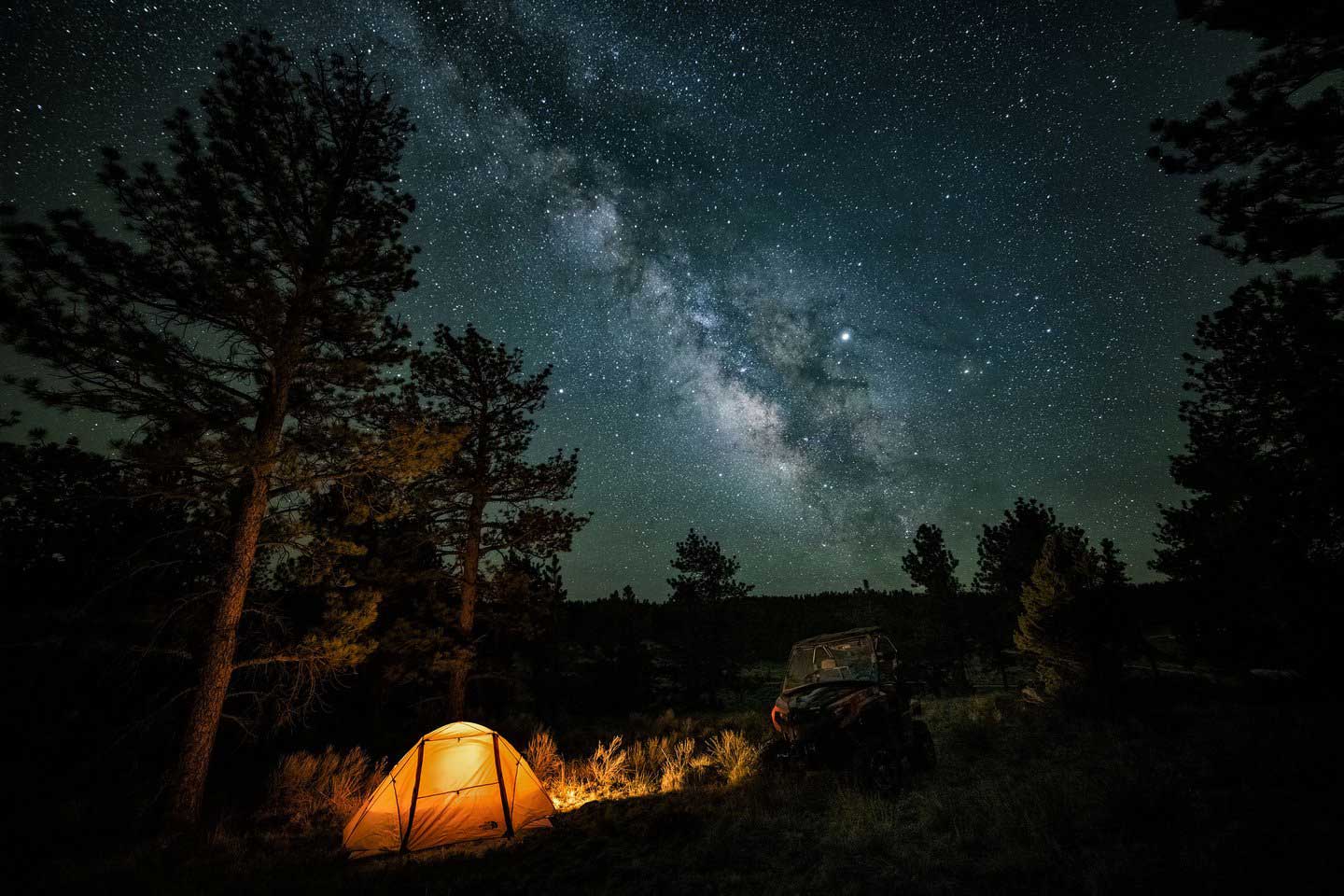While these certified destinations provide some of the darkest, clearest skies for witnessing the cosmos, there’s ample opportunity across the state’s four corners to take in starry skies.
Explore the vast beauty of the Milky Way or watch as the stars light up our tallest mountain peaks. Take a guided trip through the galaxy with an astronomer-led star party or cozy up for a private experience. Whether you lie under the heavens of the San Luis Valley or get a little closer to the stars on the peak of a stately mountain, there is nothing like seeing constellations speckled across a clear Colorado sky.
Great Sand Dunes National Park and Preserve
Mosca
A DarkSky International Park, Great Sand Dunes National Park near Alamosa is already otherworldly during the daytime, but at night, it’s easy to imagine you’re on another planet. It’s also one of the only wild places in the world where rangers encourage self-guided exploration in total darkness. To take a gorgeously surreal night hike without the aid of a flashlight, plan your visit during a full moon. You may be treated to glimpses of the local wildlife, including owls, kangaroo rats, coyotes and even bobcats. If you’re more interested in sky than sand, go during a new moon instead, and you'll get unfettered views of star-dappled skies. A variety of guided programs are also available during the summer — check the program schedule before your visit.
Garden of the Gods Road
Colorado Springs
Garden of the Gods in Colorado Springs is located far enough from city lights for a lucid view of nature's fireworks. The snow-capped white summit of Pikes Peak seems to glow in the dark, set against a backdrop of silhouetted boulders and some of the galaxy’s most beautiful stars. Take in deep breaths of fresh air, lean back and let the constellations captivate you. And when daylight breaks, take in views that are just as gorgeous as they are at night, as the striking red rock formations seem to pierce the blue sky.
Red Rocks Park & Amphitheatre
Morrison
Not only is the all-natural Red Rocks Amphitheatre in Morrison one of the world’s most desired music venues for bands and fans alike, it’s also a beautiful place to spend an evening stargazing. With its panoramic view of the city of Denver beyond and the solitude of a mountainside setting, Red Rocks is truly a gift of nature. The best time to catch the stars is during one of Red Rocks' summer concerts or Film on the Rocks.
Dinosaur National Monument
Near Dinosaur
Added to DarkSky International's list of Dark Sky Parks for its "exceptional natural darkness," Dinosaur National Monument in the far northwest corner of the state hosts ranger programs and special events May through October to get visitors deep into the dark. There are also many prime places to view the night sky with either the naked eye or telescopes and binoculars. Until now, the monument has been most famous for the epic whitewater rafting found on the Dinosaur and Yampa rivers, as well as incredibly preserved dinosaur fossils and Fremont culture rock art.
UFO Watchtower – San Luis Valley
Hooper
At the UFO Watchtower in Hooper, you're in for more than just stargazing. Locals claim the San Luis Valley is a hot spot for alien activity, and dozens of unexplained flying object sightings are rumored to have occurred at this locale since 2007. At the watchtower, there's little or no light competition obstructing your view — so it’s just you, the stars … and perhaps the occasional extraterrestrial flying by. The watchtower offers information on past “encounters” and theories behind the sightings. Come see for yourself. Maybe you’ll be one of the lucky ones. Find other quirky roadside attractions in Colorado.
Curecanti National Recreation Area
Between Gunnison and Montrose
The rugged landscape of Curecanti is a necessary beauty for everyone to experience. Come to this International Dark Sky Park on a clear night, and you’ll be certain to witness plenty of distant planets, stars and faint stardust — a glowing cloud of stars too far away to be separated by the naked eye. If the water is still, you may even catch a glimpse of the Milky Way in its reflection. Three sprawling reservoirs mark the heart of Curecanti, beginning with Colorado’s largest body of water (Blue Mesa Reservoir), followed by Morrow Point Reservoir at the entrance to the Black Canyon of the Gunnison National Park and the East Portal. A location as vast and unpopulated as this is a rarity.
Black Canyon of the Gunnison National Park
Near Montrose and Gunnison
Bordered by the vast open spaces of western Colorado, Black Canyon of the Gunnison National Park has always been a phenomenal place to see the stars. In 2015, the canyon received the International Dark Sky Park designation, officially making it one of the best places in the world to go off-grid for a few hours. The Black Canyon Astronomical Society, in partnership with other local stargazing groups, conducts nighttime programs throughout the year (with more in summer) — using both telescopes and the naked eye — with experienced astronomers and astro-photographers on hand to assist visitors in the darkness. The park also hosts an annual astronomy festival each September.
Hovenweep National Monument
Near Cortez
Straddling the Colorado and Utah border, Hovenweep National Monument is an International Dark Sky Park that also preserves Ancestral Puebloan ruins, as well as untouched views of the night sky. Some say that this civilization’s rock art, found among the national monument’s ruins, depicts major celestial events like summer and winter solstices — suggesting that the area has been a favorite for stargazing for more than 800 years. Explore this lost civilization by day to view the petroglyphs for yourself and cozy up for stargazing by night at the visitor center parking lot and campground. Visit during the spring and summer for ranger-presented stargazing programs.
